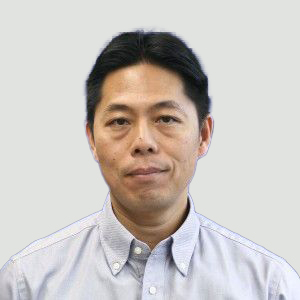Masakazu Yamamoto
Assistant Research Professor
Molecular and Cell Biology
Education:
1998 Awarded the degree of Ph.D. (Molecular biology) for a thesis entitled “Coordinated expression of Hoxa-11 and Hoxa-13 during limb muscle patterning.”
1993-1996 Department of Molecular Biology, Graduate School of Science, Nagoya University
1991-1993 Department of Biology, Graduate School of Science, Tohoku University
Awarded the degree of M.Sc.
1987-1991 Department of Biology, Faculty of Science, Tohoku University
Awarded the degree of B.Sc.
Research Interests:
2009- Assistant research professor
Molecular and Cell Biology, Center for Regenerative Biology, University of Connecticut
2003-2009 Postdoctoral fellow,
Center for Regenerative Biology, University of Connecticut
1999-2003 Research assistant professor at the Division of Biological Science,
Graduate School of Science, Nagoya University
1996-1998 Researcher at the CREST, Japan Science and Technology Corporation
Selected Publications:
Sasaki, H., Yamamoto, M., and Kuroiwa, A. Cell type dependent transcription regulation by chick homeodomain proteins. Mech Dev 37, 25-36. (1992)
Yokouchi, Y., Yamamoto, M., Toyota, T., Sasaki, H., and Kuroiwa, A. Regulatory interaction of positional signalings on coordinate expression of homeobox genes in developing limb buds. Prog Clin Biol Res 383A, 71-78. (1993)
Yokouchi, Y., Nakazato, S., Yamamoto, M., Goto, Y., Kameda, T., Iba, H. and Kuroiwa, A. Misexpression of Hoxa-13 induces cartilage homeotic transformation and changes cell adhesiveness in chick limb buds. Genes Dev 9, 2509-2522. (1995)
Murakami, M., Watanabe, H., Niikura, Y., Kameda, T., Saitoh, K., Yamamoto, M., Yokouchi, Y., Kuroiwa, A., Mizumoto, K., and Iba, H. High-level expression of exogenous genes by replication-competent retrovirus vectors with an internal ribosomal entry site. Gene 202, 23-29. (1997)
Yamamoto, M., Gotoh, Y., Tamura, K., Tanaka, M., Kawakami, A. and Kuroiwa, A. Coordinated expression of Hoxa-11 and Hoxa-13 during limb muscle patterning. Development, 125, 1325-1335. (1998)
Yamamoto, M. Molecular mechanism of limb muscle patterning (Japanese). Acta Anat Nippon 73, 667-676. (1998)
Hashimoto, K., Yokouchi, Y., Yamamoto, M. and Kuroiwa, A. Distinct signaling molecules control Hoxa-11 and Hoxa-13 expression in the muscle precursor and mesenchyme of the chick limb bud. Development, 126, 2771-2783 (1999)
Yamamoto, M. and Kuroiwa, A. Protocol of Whole-mount in situ hybridization (Japanese). Molecular Biology Protocols, Second edition, Edited by Koike, K., Sekiya, T. and Kondo, H. 362-366 (1999)
Bruneau, S., Johnson, K.R., Yamamoto, M., Kuroiwa, A. & Duboule, D. The mouse hoxd13(spdh) mutation, a polyalanine expansion similar to human type ii synpolydactyly (spd), disrupts the function but not the expression of other hoxd genes. Dev Biol 237, 345-353 (2001)
Yamamoto, M. Mechanism of limb muscle development (Japanese). Mechanism of limb development, edited by Ide, H. (IPC press), 211-250 (2003).
Yamamoto, M. and Kuroiwa, A. Hoxa AbdB genes repress MyoD expression during limb muscle development. Development Growth and Differentiation 45, 485-498 (2003)
Yamamoto, M., Watt, C.D., Schmidt, R.J., Kuscuoglu, U., Miesfeld, R.L. and Goldhamer, D.J. Cloning and characterization of a novel MyoD enhancer-binding factor. Mech Dev 124, 715-728 (2007)
Yamamoto, M., Shook, N. A., Kanisicak, O., Yamamoto, S., Wosczyna, M. N., Camp, J. R., and Goldhamer, D. J. A multifunctional reporter mouse line for Cre- and FLP-dependent lineage analysis. Genesis 47, 107-114 (2009)
Lounev, V. Y., Ramachandran, R., Wosczyna, M. N., Yamamoto, M., Maidment, A. D. A., Shore, E. M., Glaser, D. L., Goldhamer, D. J., and Kaplan, F. S. Identification of progenitor cells that contribute to heterotopic skeletogenesis. J Bone Joint Surg Am 91, 652-663 (2009)
Yamamoto, M., Watt, C.D., Yamamoto, S. and Goldhamer, D.J. Functional analysis of C2H2 Zinc finger transcription factor, Glucocorticoid-induced gene 1. In preparation.
Kanisicak, O, Mendez, J.J, Yamamoto, S, Yamamoto, M and Goldhamer, D.J. Progenitors of skeletal muscle satellite cells express the muscle determination gene. MyoD. Dev Biol 332, 131-141 (2009)
Starkey, J.D., Yamamoto, M., Yamamoto, S. and Goldhamer, D.J. Skeletal muscle satellite cells are committed to myogenesis and do not spontaneously adopt non-myogenic fates. J Histo Cyto 59, 33-46 (2011)

| masakazu.yamamoto@uconn.edu | |
| Phone | 860-486-8717 |
| Mailing Address | 91 North Eagleville Road, Unit 3125, Storrs, CT 06269-3125 |
| Office Location | Biology/Physics Building G26 |